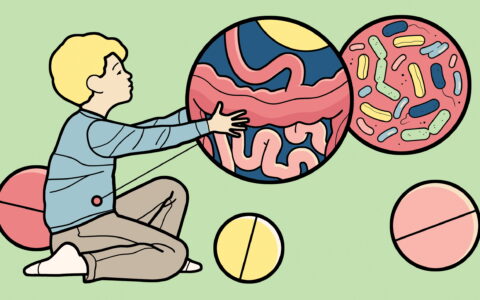Functional nausea, particularly in children, has been difficult to measure objectively or characterize spatially without an invasive procedure using sensors to evaluate the serosa.
A Vanderbilt University Medical Center team has been experimenting with ways to overcome this obstacle so that an accurate impression of slow-wave propagation, the signature means of characterizing functional nausea, can be produced.
To accomplish this, they are using magnetogastrogram (MGG), which enables a comprehensive mining of neural activity data for temporal and spatial information, much the same way an EKG provides granular information about the heart.
The research team includes L. Alan Bradshaw, Ph.D., director of the Gastrointestinal Superconducting Quantum Interference Device (SQUID) Technology Laboratory; Suseela Somarajan, Ph.D., a biomedical engineer; Sari Accra, M.D., director of the Division of Pediatric Gastroenterology; and Alexandra Russell, M.D., director of the Functional Nausea Clinic at Monroe Carell Children’s Hospital at Vanderbilt.
The work will by default forge a new definition of “functional nausea,” Bradshaw said.
An EKG for the Gut
Functional nausea was so named because it was not thought to be associated with a structural abnormality, Bradshaw explained. However, with greater understanding of the slow-wave activity that controls motility, the condition’s roots in neural pathway dysfunction are now better appreciated.
Almost like a pacemaker, the interstitial cells of Cajal help regulate slow waves in the gut that move along neural pathways in the stomach after food is ingested. Russel examined those movements in a study of children with and without functional nausea. Her results, soon to be published, found distinct variations.
Detection and Magnetism
Bradshaw has long been using biomagnetic technology in research as a sensitive means of verifying EGG readings and a potential alternative to EGG.
His lab focuses on detection and characterization of pediatric chronic nausea, gastroparesis and intestinal ischemia, and he has been a leader in developing the utility of the SQUID magnetometer to validate EGG findings as well as to uncover more specific data that may help in diagnosis and treatment.
“The magnetic coils we use are highly sensitive and specific, but when applied directly to the body surface, they are overcome by the magnetic forces of the earth,” Bradshaw said. “So, we constructed a system by which we convert signals received from the magnetic detection and localization coils to electric signals that are then sent to the SQUID’s coils for amplification. This gives us the ability to measure the slow waves in a spatiotemporal manner.”
MGG has been shown to detect more subtle electrical signals and to be effective at matching slow-wave activities with their site of origin. In one study, Bradshaw and his colleagues demonstrated a magnetic technology that was able to identify and classify the spatial signatures of slow-wave activity. In another, they validated the MGG’s ability to track subject-specific anatomy by comparing readings with serosal slow-wave measurements.
Two primary limitations to use of the SQUID are that it is not portable and must be used in a shielded room, the researchers said.
“We’re trying to figure out the differences between electric and magnetic modalities, and when it’s indicated to use one instead of the other,” Bradshaw said.
Adjusting the Clinical Focus
Russell is a pioneer in the use of information from EGGs and MGGs to characterize diseases in different patients. In her recent study, she examined healthy children alongside those with active nausea and with a history of nausea but who were not nauseous at the time of exam.
“Our work shows that there is actually something physiological going wrong in the stomach. That’s really validating for patients and potentially helpful in determining medical treatment.”
“In healthy controls, we found that the muscle contractions follow a consistent pattern, squeezing food down from the stomach into the small intestine,” Russell said. “But in kids who have functional nausea, even if they’re not nauseous at the time of the evaluation, those waves may be disorganized and ineffective or retrograde. We didn’t know that before now.”
The electrogastrogram (EGG), the predominant non-invasive tool for detecting the electrical signals associated with slow-wave activity, performs a similar function but has a clinical limitations because it also picks up considerable noise and crossover between signals, the researchers said.
Recent findings diverge from the historical understanding of functional nausea as a bidirectional brain-gut issue, since patient gastric-emptying studies and lab results are often normal.
“Along with standard medications, we have focused on teaching coping skills and using cognitive behavioral therapy,” she said. “While this is very important, our work shows that there is actually something physiological going wrong in the stomach. That’s really validating for patients and potentially helpful in determining medical treatment.”
In the next stage of studies, her team will induce anxiety in children through tactics such as math challenges to measure changes in the slow-wave patterns. Separately, they will provide guided meditation or clinical hypnosis, which has been shown to help nausea.
These tests may help prove the value of treatment options beyond standard medications. And the approach to medication is expanding, too. Insight into the variances in slow-wave patterns is leading the Vanderbilt team to begin thinking harder about personalized therapies.
“We’ve been looking at our success rates in controlling nausea in children with odansetron or cyproheptadine, which helps the stomach hold food more comfortably,” Russell said. “If we don’t see changes, maybe they need a peripheral nerve stimulant or a drug for nerve hypersensitivity, like amitriptyline.
“It’s important to individualize treatment, because we don’t have an objective measure for nausea. The utility of these EGGs and MGGs is that we can better quantify patients’ response to therapies and better target the symptoms.”





